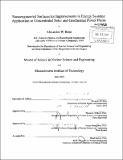Nanoengineered surfaces for improvements in energy systems : application to concentrated solar and geothermal power plants
Author(s)
Rehn, Alexander W. (Alexander William)
DownloadFull printable version (24.34Mb)
Other Contributors
Massachusetts Institute of Technology. Dept. of Nuclear Science and Engineering.
Advisor
Thomas J. McKrell.
Terms of use
Metadata
Show full item recordAbstract
The main drawback to renewable energy systems is the higher cost of production compared to competitors such as fossil fuels. Thus, there is a need to increase the efficiency of renewable energy systems in an effort to make them more cost competitive. In this study, the use of nanosurfaces is evaluated for its benefits in improving the efficiency of a concentrated solar tower power system by increasing the energy retained by the receiver surface, and for reducing the fouling on geothermal heat exchangers. The samples tested for the solar receiver application were Inconel 617, Inconel 617 with a 150 nm layer of platinum, Inconel 617 with a 150 nm layer of platinum and a 550 nm layer of nickel oxide, oxidized nickel, and silicon carbide. The experimental results indicated that the platinum was an ineffective diffusion barrier, nickel oxide displays solar selective properties, and silicon carbide would be the best choice for a surface among the samples tested. This indicates that at the operating temperatures for this receiver at 700 °C, a black body surface is more effective than a practical solar selective surface. The nanosurfaces tested for the antifouling application in geothermal systems were subjected to chemistry conditions similar to that in a Dry Cooling Tower at a geothermal plant in Larderello, Italy. Each sample's performance was measured by determining each samples weight change and surface characterization after exposure in an experimental loop. The best performing coatings, all of which showed negligible weight gain, were the Curran 1000 coating from Curran International, the Curran 1000 coating with nanographene, and the Curralon coating with PTFE. Upon further analysis, the Curran 1000 with nanographene was identified as the most promising coating option.
Description
Thesis (S.M.)--Massachusetts Institute of Technology, Dept. of Nuclear Science and Engineering, 2012. Cataloged from PDF version of thesis. Includes bibliographical references (p. 140-148).
Date issued
2012Department
Massachusetts Institute of Technology. Department of Nuclear Science and EngineeringPublisher
Massachusetts Institute of Technology
Keywords
Nuclear Science and Engineering.